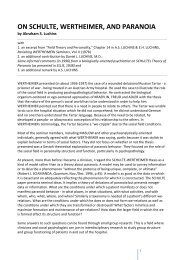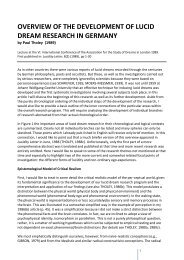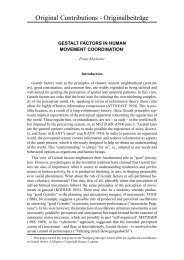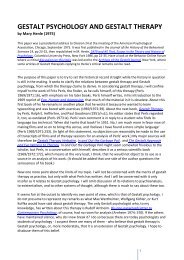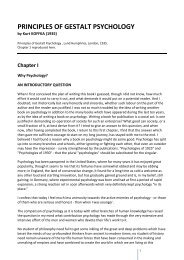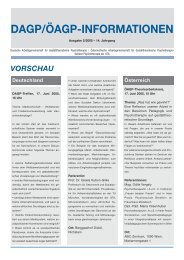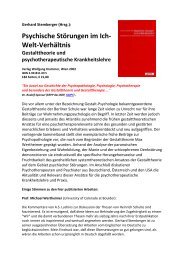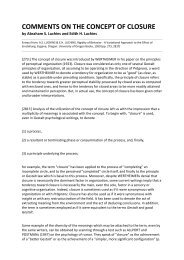pdf-Download - Society for Gestalt Theory and its Applications (GTA)
pdf-Download - Society for Gestalt Theory and its Applications (GTA)
pdf-Download - Society for Gestalt Theory and its Applications (GTA)
You also want an ePaper? Increase the reach of your titles
YUMPU automatically turns print PDFs into web optimized ePapers that Google loves.
BORING went on to conjecture about how KÖHLER came to the concept of psychoneuralisomorphism:When KÖHLER participated in the founding of <strong>Gestalt</strong> psychology (1920), he made over [George E.] MÜLLER's [1897]axioms in accordance with the new unanalytical dynamic conceptions. It was he, indeed, who applied the termisomorphism to this psychoneural relation, he <strong>and</strong> his colleagues who made the concept so important in <strong>Gestalt</strong>psychology that it is not always possible in their writings to distinguish between the phenomenal field <strong>and</strong> thecorrelated brain field. He was, nevertheless, explicit. The relationship is one of topological order, not of identity of sizeor shape (BORING, 1942, p. 90).BORING continued by quoting KÖHLER s statements in his <strong>Gestalt</strong> Psychology (1929, pp. 64-66):all experienced order in space is a true representation of a corresponding order in the underlying dynamical context ofphysiological processes (p. 64)-.experienced order in time is a true representation of the corresponding concrete orderin the underlying dynamical context (p. 65). And the law <strong>for</strong> phenomenal organization is similar: to a context,experienced as "one thing" belonging together, there corresponds a dynamical unit or whole in the underlyingphysiological processes (p. 66). "In this respect again, the order of experience is a true representation of acorresponding functional order in the processes upon which it depends" (Ibid.).BORING also discussed isomorphism in relation to WERTHEIMER's experiments on the phiphenomenon in a section called "Perceived Movement" (pp. 595-596). Using a tachistoscope,WERTHEIMER arranged <strong>for</strong> a single discrete displacement of a simple geometric object, such as aline segment.The first member presented he designated a, the second b. When the time interval between a <strong>and</strong> b was relativelylong (about 200 millisec.), the subject perceived succession, first a, then b. When the interval was very short (less than30 millisec.), the perception was one of simultaneity, a <strong>and</strong> b together. In between successivity <strong>and</strong> simultaneity hegot movement, the optimal interval <strong>for</strong> which was about 60 millisec. [This gave rise to] the case of pure movement,which WERTHEIMER named phi-movement which connects the objects <strong>and</strong> has direction between them, but seemsnot in <strong>its</strong>elf to be an object.... For optimal movement one sees a single object moving, not an a turning into a b. In this contention WERTHEIMERwas following out the tradition of MACH <strong>and</strong> EXNER, but he went further. He insisted on the validity of movement asan immediate experience without reference to basic constituents, on the "givenness" of <strong>and</strong> <strong>its</strong> irreducibility in termsof space <strong>and</strong> time. Out of such an intransigent phenomenology arose <strong>Gestalt</strong> psychology.There is one other item of importance in WERTHEIMER's paper. He suggested that seen movement may be theconsequence of a "physiological short-circuit" in the brain. Given exactly the right time-interval, the excitation at onepoint may be drawn over to become the excitation at the other, the process being - not a retinal process... - but acortical process which is the physiological substrate of apparent movement. This <strong>for</strong>m of psychophysical parallelismfollows the axioms of MACH <strong>and</strong> G.E. MÜLLER, <strong>and</strong> anticipates the isomorphism of KÖHLER which has become sonearly an indispensable of <strong>Gestalt</strong> psychology.WERTHEIMER's paper, supported presently by the enthusiasm of the growing school of <strong>Gestalt</strong> psychology, was agreat success, <strong>for</strong> it was the starting point of well over a hundred papers on apparent movement during the next thirtyyears. At first there were but a few studies by <strong>Gestalt</strong> psychologists in Germany under the influence of KOFFKA <strong>and</strong>KÖHLER, but the Americans took up the topic in the 1920 s with considerable zeal. (BORING, 1942, pp. 595-596)He noted: "So well does WERTHEIMER s cortical short circuit fit the isomorphism of <strong>Gestalt</strong>psychology that KÖHLER elaborated <strong>and</strong> modified the theory in 1923, shortly after he had laiddown his general principles <strong>for</strong> isomorphic brain fields in his Physische <strong>Gestalt</strong>en of 1920" (1942, p.599).In the notes BORING provided references, including those that contained criticisms, his own <strong>and</strong>others, of the concept of isomorphism in <strong>Gestalt</strong> psychology. [fn 3] He summarized some of thecriticisms:The criticism of psychoneural isomorphism has come from the physiologists <strong>and</strong> the positivistic psychologists. Thephysiologists said that the brain is, in general, a net-work of connections, not a field where dynamic <strong>for</strong>ces, such as the<strong>Gestalt</strong> psychologists find in perception, can exist. The future will decide that point. Even the physiologists know littleas yet about the action of the brain. The positivists said that a mere statement of correspondence between mind <strong>and</strong>body is not enough, that they wished to know how the one affects the other, <strong>and</strong> that operational analysis of thenature of the available evidence <strong>for</strong> isomorphism shows that the axioms should be rewritten so as to staterelationships between neural events - between events in the brain <strong>and</strong> the other physiological events involved in the15



